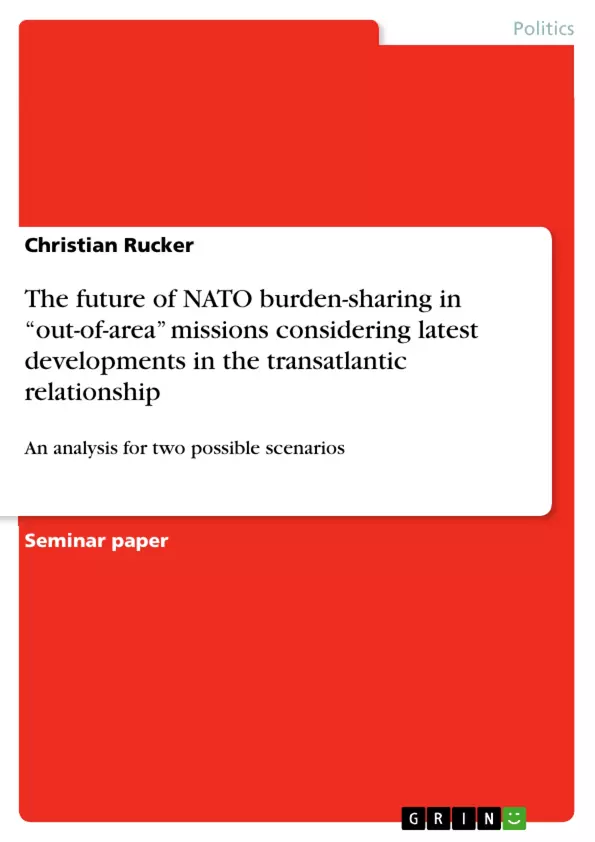NATO (North Atlantic Treaty Organization) experienced an interesting and – speaking of a military alliance – an unparalleled development in recent years. It changed from an alliance of collective defense with a declared enemy to a multifunctional alliance for collective security. Not only was and is it the only contractual basis between the partners on both sides of the Atlantic but – despite all differences – it was to form a community of values among its members.
However, it is rather uncertain to predict whether or not both sides of the Atlantic will continue in that mentality. Therefore based on two possible trends regarding NATO, the author of this work is going to examine how the relationship of the alliance changed or is going to change on principle and in some particular cases of “out of area” operations and stabilizing missions. Within this context future possibilities, political wills on both sides of the Atlantic, as well as alternative regional approaches in regard to this type of tasks will be observed here. Subject to this survey are also current developments and fundamental strategic considerations regarding the transatlantic relationship within NATO context and burden sharing.
Inhaltsverzeichnis (Table of Contents)
- Latest trends in the development of NATO
- Growing Problems and tensions in transatlantic relationship - two possible scenarios
- Scenario 1 - Revitalization of a collective security alliance with two strategic pillars
- Scenario 2 - An increasing state of competition between NATO/EU and US/EU
- The question and lesson of burden sharing in Afghanistan and after
- Afghanistan and after – the need for a more flexible approach
- The US. \"Pivot to Asia\" and the challenge for Europe - Smart Defence/Pooling and Sharing as a solution?
- Solution approaches for a more equal burden sharing in a pragmatic and more autonomous transatlantic relationship
- Conclusion and Outlook
Zielsetzung und Themenschwerpunkte (Objectives and Key Themes)
This paper examines the future of NATO burden sharing in light of the evolving transatlantic relationship and the rise of "out-of-area" missions. It analyzes two possible scenarios for the future of NATO and the transatlantic relationship, considering the latest developments in both. The paper aims to provide a nuanced understanding of the challenges and opportunities facing NATO in the 21st century.
- The changing nature of NATO from a collective defense alliance to a multifunctional alliance for collective security
- The growing tensions and diverging interests between the United States and Europe within the NATO framework
- The challenges of burden sharing in "out-of-area" missions, particularly in Afghanistan
- The potential for increased cooperation and coordination between NATO and other international actors, such as regional partners
- The need for a more flexible and adaptable NATO structure to meet the challenges of the 21st century
Zusammenfassung der Kapitel (Chapter Summaries)
Chapter 1 analyzes the latest trends in the development of NATO, highlighting its transformation from a collective defense alliance to a multifunctional alliance for collective security. It examines the changing security environment and the impact of NATO's enlargement on its internal structure. The chapter also addresses the increasing divergence of interests and perceptions between the United States and Europe.
Chapter 2 outlines two possible scenarios for the future of NATO and the transatlantic relationship. The first scenario envisions a revitalized NATO with increased cooperation and consultation among its members, including potential partnerships with regional actors. The second scenario predicts a more fragmented and less cooperative NATO, characterized by a greater emphasis on ad hoc coalitions of the willing.
Chapter 3 focuses on the question of burden sharing in "out-of-area" missions, particularly in Afghanistan. It highlights the need for a more flexible approach to burden sharing and explores the challenges posed by the US "Pivot to Asia" for European security. The chapter also examines the potential of "Smart Defence" and pooling and sharing initiatives to address these challenges.
Chapter 4 proposes solutions for a more equal burden sharing within a pragmatic and more autonomous transatlantic relationship. It emphasizes the need for a more flexible and adaptable NATO structure, as well as a greater emphasis on cooperation and coordination with regional partners.
Schlüsselwörter (Keywords)
The main keywords and focus topics of this work include NATO, transatlantic relations, burden sharing, out-of-area missions, collective security, strategic partnerships, "Smart Defence", pooling and sharing, Europeanization, and the US "Pivot to Asia". The paper examines the evolving multipolar world order and the challenges it poses for NATO and the transatlantic relationship.
- Arbeit zitieren
- Christian Rucker (Autor:in), 2014, The future of NATO burden-sharing in “out-of-area” missions considering latest developments in the transatlantic relationship, München, GRIN Verlag, https://www.grin.com/document/320928



